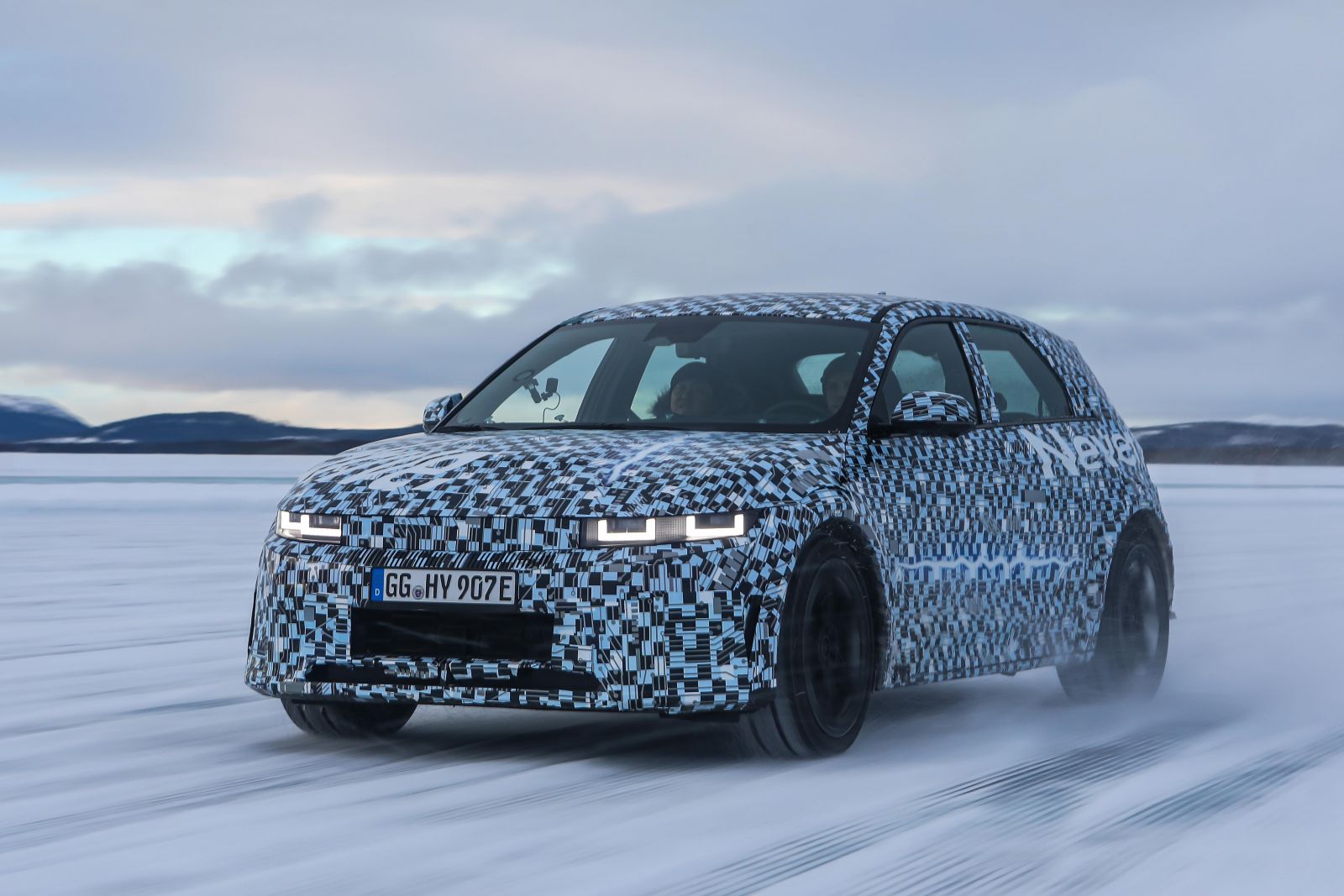The world of more affordable performance electric vehicles (EVs) is heating up.
Kia recently dropped its supercar-fast Kia EV6 GT and Hyundai will be the next cab off the rank an N-fettled supercar version of its EV, dubbed the Hyundai Ioniq 5 N.
We had the unique opportunity to join Hyundai’s testing team in Sweden as they fine tuned the electronic stability controls.
While we couldn’t see the complete vehicle, we had a great opportunity to get up close and personal with an Ioniq 5 N prototype and test some of its segment-first electronic controls.
We’ll have some video of it in action in the coming weeks, but in the interim enjoy the words and pics below, which detail the experience.
How much does the Hyundai Ioniq 5 N cost?
We don’t know Ioniq 5 N pricing just yet, but it’s likely to sit in the same ballpark as the hot Kia EV6 GT.
The EV6 GT is priced from just under $100,000, and it’s likely Hyundai will aim for a similar figure given it wants to go head-to-head with the likes of the Tesla Model 3 and Model Y Performance. Bear in mind, the Ioniq 5 is more a Model Y-sized vehicle than a Model 3.
Hyundai’s current Ioniq 5 line-up extends to $85,000 for the Ioniq 5 Epiq AWD.
What is the Hyundai Ioniq 5 N like on the inside?
Our preview of the Hyundai Ioniq 5 N was at the Mobis proving ground in Arjeplog, which is a small town located within the arctic circle in Sweden.
The town is best known as being the winter test bed for most big manufacturers, with most using or sharing one of the many proving ground test areas in the region.
As a result of us being at a top secret proving ground, we weren’t able to take any pictures ourselves. Additionally, Hyundai said parts of the interior were incomplete, so all we can do is describe what it all looked like.
Inside the cabin it looked and felt like a regular Ioniq 5 for the most part, but the biggest changes were in the seats, steering wheel switchgear, and visual highlights on the dashboard.
The seats were super comfy and hug you in tightly. They’re reminiscent of the seats in the Kia EV6 GT with holes at the top to feed through harness belts.
The steering wheel was the biggest difference between the N and a regular Ioniq 5. In addition to drive mode buttons on top of the steering wheel, an additional set of buttons are fitted to the lower part of the steering wheel similar to the N Grin Shift button on some internal-combustion N models.
They had stickers on them, but we think they may have been hiding screens behind the stickers similar to what you see in Mercedes-AMG vehicles.
Additionally, the steering wheel felt fatter in the hands, kind of like what you find on BMW vehicles with M Sport packages. While some people in our group weren’t a fan of the way it felt, I thought it was perfect for that application.
Behind the steering wheel were a set of paddles, and we will explain the function of those later.
What’s under the bonnet?
Hyundai was tight-lipped on how much power and torque the Ioniq 5 N would produce, but we were able to read between the lines.
Beneath the skin the Ioniq 5 N uses a next-generation battery pack. The pack is around 80kWh in size, but offers better energy density than the regular Ioniq 5.
This new chemistry has allowed Hyundai to draw more current from the battery quickly, which helps with performance and durability.
On power and torque, we heard the figure 600hp (447kW) mentioned several times, which leads us to believe Ioniq 5 N will produce more power than the EV6 GT. The EV6 GT produces 430kW of power when the front and rear motors reach their peak.
Inner-motor cooling helps the EV6 GT achieve higher motor revs, which in turn allows it to achieve a top speed of 260km/h using a single gear (unlike the Porsche Taycan, which uses a two-speed transmission). It’s not clear if the Ioniq 5 N will use the same system.
Electrical infrastructure remains the same, with Ioniq 5 N using a 800V electrical architecture capable of up to 350kW charging on DC and 11kW three-phase AC.
There’s also vehicle-to-load through a power outlet under the rear seat or an adaptor for the charging port, capped at 15A and 3.6kW.
Visible beneath the camouflage were functional vents for the rear axle (presumably for additional motor cooling) and larger air vents at the front. A big diffuser could be seen at the rear, in addition to a wider set of treads.
How does the Hyundai Ioniq 5 N drive?
Travelling around the globe to events like this is a great opportunity to speak with the engineers that work on these vehicles day in and day out.
Albert Biermann (former head of N, now a strategic advisor to the brand) built a highly skilled and capable team around him to deliver ambitious projects like the Ioniq 5 N.
It’s the first Ioniq 5 vehicles to feature adaptive damping, along with a number of software-driven programs to improve the driver experience behind the wheel.
I’ll cover off as many of these as I can (and the ones we could test).
Exterior/interior sound
Hyundai will offer the Ioniq 5 N with the ability for users to switch and even create their own acceleration sounds.
Down the track, the plan is to build a platform allowing customers to upload their own sounds to the vehicle to further personalise them beyond what Hyundai offers.
We tested out a few of the sounds Hyundai offers at the moment and while they add to the experience, they’re the types of sounds that I find detract from the driving experience – but they do come in handy for one of the next features.
Drift Mode
Now this I seriously liked. Hyundai has engineered a full-blown Drift Mode, but it’s not just a case of disabling the front axle and feeding everything to the rear.
Hyundai engineers used drift experts within their team to fine tune the system and turn the Ioniq 5 N into a bona-fide drift machine. We had the chance to test this on a frozen lake within the Mobis test facility and the results were surprising.
You’re dealing with a surface that has very, very low friction levels. The surface then has friction level adjustments as you hit parts of graded ice and migrate to ungraded ice.
The vehicle has to deal with these sudden grip level changes almost instantly to stop you from spinning.
Admittedly, no matter how hard I tried it was almost impossible to spin the Ioniq 5 N. You could keep feeding the throttle and inputting steering to keep the car in a perfect slide around the huge ice circle.
How does sound help this? Unlike a regular internal-combustion car that makes more noise when you input more throttle, an EV doesn’t – and it’s hard to gauge what reaction your input is going to have until it’s too late.
The motor sounds are designed to give you a better impression of the relationship between throttle input and wheel slip, and the systems can then adjust accordingly.
Variable torque control
We’ve seen this feature previously in Tesla Performance vehicles.
Track mode allows the driver to adjust the torque split between the front and rear axle anywhere from 100 per cent front-wheel drive to 100 per cent rear-wheel drive or 10 per cent intervals between.
This was good fun to try out on both the ice lake and a handling course setup a little further away. We could toy with how well the car handled with traction control limited, or traction control fully off (and it really is fully off).
The curious thing we found on ice, where throttle inputs could instantly send the motors into a 20,000rpm free spin, Hyundai has dialled in a soft limiter when there is an excessive delta between wheel speed and vehicle speed.
For example, if you’re stationary with traction control off and you feed a too much throttle in, instead of allowing the wheels to spin up to 200km/h on the spot, a soft limiter will hit when a preset delta is achieved.
This slightly affects things like Drift Mode where you need a little bit of wheel slip to keep things moving, but it’s easily overcome by going off and then back on the throttle quickly.
Fake gear shifts
Here’s something I never thought I’d be writing about – fake gear shifts in an EV. Hyundai has engineered a CVT-esque system where the driver can put the vehicle into a manual mode.
In the manual mode it brings up a tachometer ahead of the driver that pulls to something like 8000rpm, even though the motors can, in theory, spin up to over 20,000 rpm.
As the tacho reaches redline, torque tapers off until the driver uses the paddle shifters to grab the next gear. During these fake gear shifts, there’s a slight pulse through the motors to simulate a gearshift.
It’s a bizarre experience, but Hyundai thinks it’s the way it’ll be able to better bridge the gap between internal-combustion and electric vehicles.
e-LSD
An e-LSD isn’t a groundbreaking concept, but its application in an EV works really well.
It’s an electronically-controlled limited-slip differential that allows the car to perform both limited-slip on the rear axle and torque vectoring via braking on the front axle.
At the rear it prevents an inside wheel spinning faster than its outside counterpart, which can happen pretty quickly in an EV that spins up torque suddenly.
The benefit of this in real terms is when the traction control is switched off. You can drive more aggressively, without just relying on the brakes to support the other assistance systems through brake biased torque vectoring.
Hyundai also uses the e-LSD to help initiate the Drift Mode by sending a sudden surge of torque to the rear axle, while locking the differential to get the vehicle to step out sideways.
Australian ride and handling tune
An Australian team has been involved in the ride and handling tune of Ioniq 5 N abroad, and it’s expected to get a once-over when it gets to Australia as well.
It’s a pretty unique position to be in given most markets will simply get the same tune regardless of road conditions in their respective countries.
CarExpert’s Take on the Hyundai Ioniq 5 N
Unfortunately it’s hard to convey a lot of what I’ve described above without images.
We will have some video content coming later this month – although even that won’t be as comprehensive as our regular uploads – that will hopefully describe it in a bit more detail.
Either way, our brief sample of the Ioniq 5 N excites us to have a proper drive of it once it launches.
Hyundai says it’ll take the wraps off the Ioniq 5 N in July 2023, and it’ll go on sale in Australia late-2023 or early-2024.
It’s likely to be heavy given the sizeable battery pack, e-LSD and meaty motors, but given how much effort Hyundai has put into tuning, it’ll likely \be a stack of fun to drive and we can’t wait to test it out locally.
Click the images for the full gallery



















